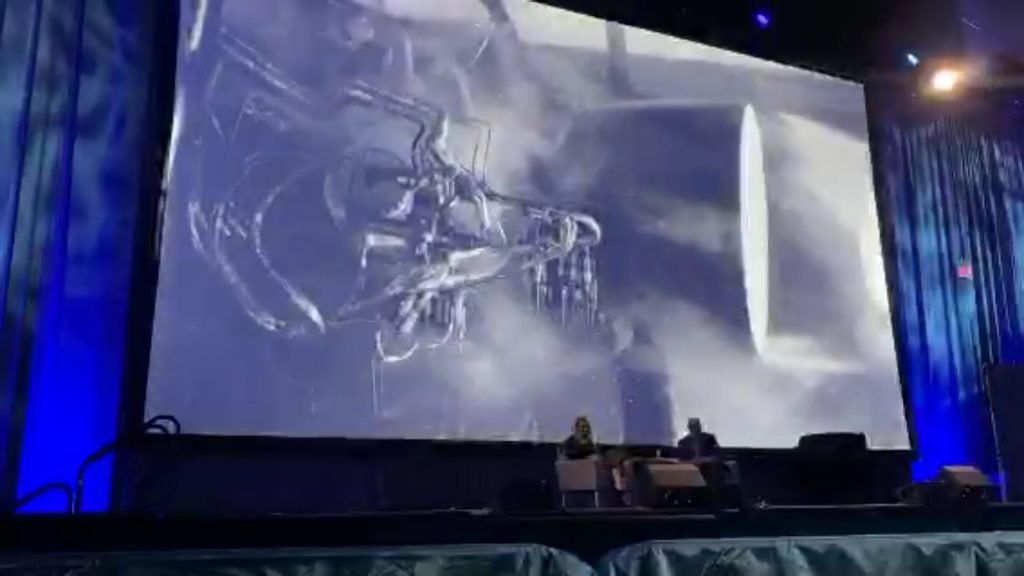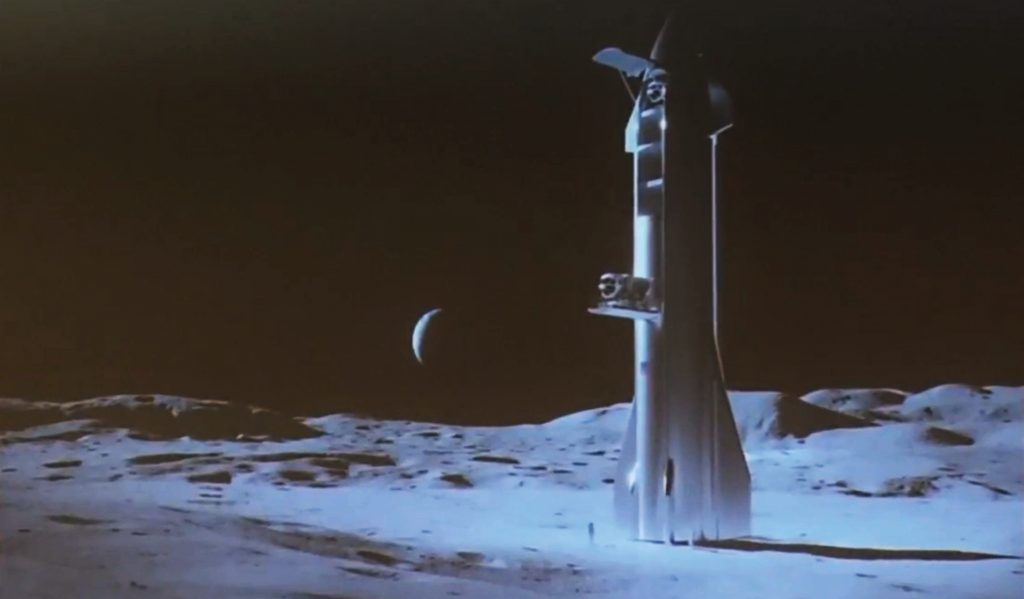

News
SpaceX’s Starship facilities, Raptor testing, and more shown off in new video
SpaceX has teased a video highlighting all aspects of its next-generation Starship rocket, ranging from new views of the Starship Mk1 prototype in Boca Chica to slow-motion clips of Raptor engine static fire tests in McGregor, Texas.
2019’s International Astronautical Congress (IAC) has included multiple SpaceX presentations, culminating on October 22nd with a discussion panel featuring SpaceX COO and President Gwynne Shotwell. Aside from offering some excellent details on the progress being made by SpaceX Starlink program, Shotwell also debuted a new Starship-centric video, featuring a range of new views of SpaceX’s next-generation rocket development program.
IAC 2019 attendee Trevor Mahlmann was able to stream the bulk of the panel, including Shotwell’s minute-long Starship program redux. Aside from a new perspective of Starhopper after its second and final test flight, perhaps the most notable new footage offered a select few glimpses of Starship Mk1’s build process. Drone timelapses and video taken from inside Starship’s tank section – prior to the installation of its third and final dome – are a strong confirmation that SpaceX is constantly acquiring high-quality footage throughout the development program.
Additionally, a back-to-back series of new videos of Raptor engine static fire testing may have been a sort of highlight reel of Raptor SN06 – the first engine to successfully make it through SpaceX’s preflight test regime – before it supported Starhopper’s final flight test in August 2019. It could nevertheless be any number of engines, as SpaceX continues to build and test Raptors at an accelerating rate.

Meanwhile, beyond Shotwell’s October 22nd discussion panel, SpaceX Principal Mars Development Engineer Paul Wooster revealed additional previously-unseen views of Starship – this time in the form of a lunar landing render. This particular render featured an unusual setup in which Starship appeared to have opened garage door-style hatches along its hull after landing on the Moon, revealing what can be assumed to be cargo bays.

In an even weirder twist, a large Moon rover appears to be heading to the lunar surface on a section of Starship’s detached hull that has been transformed into an ad-hoc elevator. The quality of the screenshot is subpar but there are no obvious strings or wires, suggesting that the implied elevator is some sort of track built directly onto the exterior of Starship’s hull. What is likely an astronaut stands on the surface, awaiting the delivery if their fresh Moon rover.
It’s unclear if the recent burst of Starship-related disclosures and teasers from SpaceX executives and senior employees is a glimpse behind the curtains or a sign of a new stage of seriousness and company-wide interest in the next-generation rocket, but it doesn’t look like it’s going to be stopping anytime soon. Up next for Starship is a critical 20 km (12 mi) flight test that will use the Mk1 prototype to determine whether SpaceX’s exotic skydiver-like recovery method is a viable option for landing on Earth and Mars. A different SpaceX presenter indicated that that test flight could occur as early as December 2019.
If successful, SpaceX CEO Elon Musk has said that the very next Starship flight test could be the spacecraft’s first attempted orbital flight. It’s far more likely that many more test flights – possibly including Super Heavy booster hops – will occur before an orbital launch attempt is made. Still, Musk believes that it could occur as few as six months from now, while Shotwell (often known for her more down-to-earth approach to schedule estimates) stated at IAC 2019 that she hoped it would occur “within a year”.
Starship’s first operational cargo mission to the surface of the Moon would then follow as early as 2022.
Check out Teslarati’s Marketplace! We offer Tesla accessories, including for the Tesla Cybertruck and Tesla Model 3.

Elon Musk
Elon Musk and Tesla AI Director share insights after empty driver seat Robotaxi rides
The executives’ unoccupied tests hint at the rapid progress of Tesla’s unsupervised Robotaxi efforts.

Tesla CEO Elon Musk and AI Director Ashok Elluswamy celebrated Christmas Eve by sharing personal experiences with Robotaxi vehicles that had no safety monitor or occupant in the driver’s seat. Musk described the system’s “perfect driving” around Austin, while Elluswamy posted video from the back seat, calling it “an amazing experience.”
The executives’ unoccupied tests hint at the rapid progress of Tesla’s unsupervised Robotaxi efforts.
Elon and Ashok’s firsthand Robotaxi insights
Prior to Musk and the Tesla AI Director’s posts, sightings of unmanned Teslas navigating public roads were widely shared on social media. One such vehicle was spotted in Austin, Texas, which Elon Musk acknowleged by stating that “Testing is underway with no occupants in the car.”
Based on his Christmas Eve post, Musk seemed to have tested an unmanned Tesla himself. “A Tesla with no safety monitor in the car and me sitting in the passenger seat took me all around Austin on Sunday with perfect driving,” Musk wrote in his post.
Elluswamy responded with a 2-minute video showing himself in the rear of an unmanned Tesla. The video featured the vehicle’s empty front seats, as well as its smooth handling through real-world traffic. He captioned his video with the words, “It’s an amazing experience!”
Towards Unsupervised operations
During an xAI Hackathon earlier this month, Elon Musk mentioned that Tesla owed be removing Safety Monitors from its Robotaxis in Austin in just three weeks. “Unsupervised is pretty much solved at this point. So there will be Tesla Robotaxis operating in Austin with no one in them. Not even anyone in the passenger seat in about three weeks,” he said. Musk echoed similar estimates at the 2025 Annual Shareholder Meeting and the Q3 2025 earnings call.
Considering the insights that were posted Musk and Elluswamy, it does appear that Tesla is working hard towards operating its Robotaxis with no safety monitors. This is quite impressive considering that the service was launched just earlier this year.
Elon Musk
Starlink passes 9 million active customers just weeks after hitting 8 million
The milestone highlights the accelerating growth of Starlink, which has now been adding over 20,000 new users per day.

SpaceX’s Starlink satellite internet service has continued its rapid global expansion, surpassing 9 million active customers just weeks after crossing the 8 million mark.
The milestone highlights the accelerating growth of Starlink, which has now been adding over 20,000 new users per day.
9 million customers
In a post on X, SpaceX stated that Starlink now serves over 9 million active users across 155 countries, territories, and markets. The company reached 8 million customers in early November, meaning it added roughly 1 million subscribers in under seven weeks, or about 21,275 new users on average per day.
“Starlink is connecting more than 9M active customers with high-speed internet across 155 countries, territories, and many other markets,” Starlink wrote in a post on its official X account. SpaceX President Gwynne Shotwell also celebrated the milestone on X. “A huge thank you to all of our customers and congrats to the Starlink team for such an incredible product,” she wrote.
That growth rate reflects both rising demand for broadband in underserved regions and Starlink’s expanding satellite constellation, which now includes more than 9,000 low-Earth-orbit satellites designed to deliver high-speed, low-latency internet worldwide.
Starlink’s momentum
Starlink’s momentum has been building up. SpaceX reported 4.6 million Starlink customers in December 2024, followed by 7 million by August 2025, and 8 million customers in November. Independent data also suggests Starlink usage is rising sharply, with Cloudflare reporting that global web traffic from Starlink users more than doubled in 2025, as noted in an Insider report.
Starlink’s momentum is increasingly tied to SpaceX’s broader financial outlook. Elon Musk has said the satellite network is “by far” the company’s largest revenue driver, and reports suggest SpaceX may be positioning itself for an initial public offering as soon as next year, with valuations estimated as high as $1.5 trillion. Musk has also suggested in the past that Starlink could have its own IPO in the future.
News
NVIDIA Director of Robotics: Tesla FSD v14 is the first AI to pass the “Physical Turing Test”
After testing FSD v14, Fan stated that his experience with FSD felt magical at first, but it soon started to feel like a routine.

NVIDIA Director of Robotics Jim Fan has praised Tesla’s Full Self-Driving (Supervised) v14 as the first AI to pass what he described as a “Physical Turing Test.”
After testing FSD v14, Fan stated that his experience with FSD felt magical at first, but it soon started to feel like a routine. And just like smartphones today, removing it now would “actively hurt.”
Jim Fan’s hands-on FSD v14 impressions
Fan, a leading researcher in embodied AI who is currently solving Physical AI at NVIDIA and spearheading the company’s Project GR00T initiative, noted that he actually was late to the Tesla game. He was, however, one of the first to try out FSD v14.
“I was very late to own a Tesla but among the earliest to try out FSD v14. It’s perhaps the first time I experience an AI that passes the Physical Turing Test: after a long day at work, you press a button, lay back, and couldn’t tell if a neural net or a human drove you home,” Fan wrote in a post on X.
Fan added: “Despite knowing exactly how robot learning works, I still find it magical watching the steering wheel turn by itself. First it feels surreal, next it becomes routine. Then, like the smartphone, taking it away actively hurts. This is how humanity gets rewired and glued to god-like technologies.”
The Physical Turing Test
The original Turing Test was conceived by Alan Turing in 1950, and it was aimed at determining if a machine could exhibit behavior that is equivalent to or indistinguishable from a human. By focusing on text-based conversations, the original Turing Test set a high bar for natural language processing and machine learning.
This test has been passed by today’s large language models. However, the capability to converse in a humanlike manner is a completely different challenge from performing real-world problem-solving or physical interactions. Thus, Fan introduced the Physical Turing Test, which challenges AI systems to demonstrate intelligence through physical actions.
Based on Fan’s comments, Tesla has demonstrated these intelligent physical actions with FSD v14. Elon Musk agreed with the NVIDIA executive, stating in a post on X that with FSD v14, “you can sense the sentience maturing.” Musk also praised Tesla AI, calling it the best “real-world AI” today.








